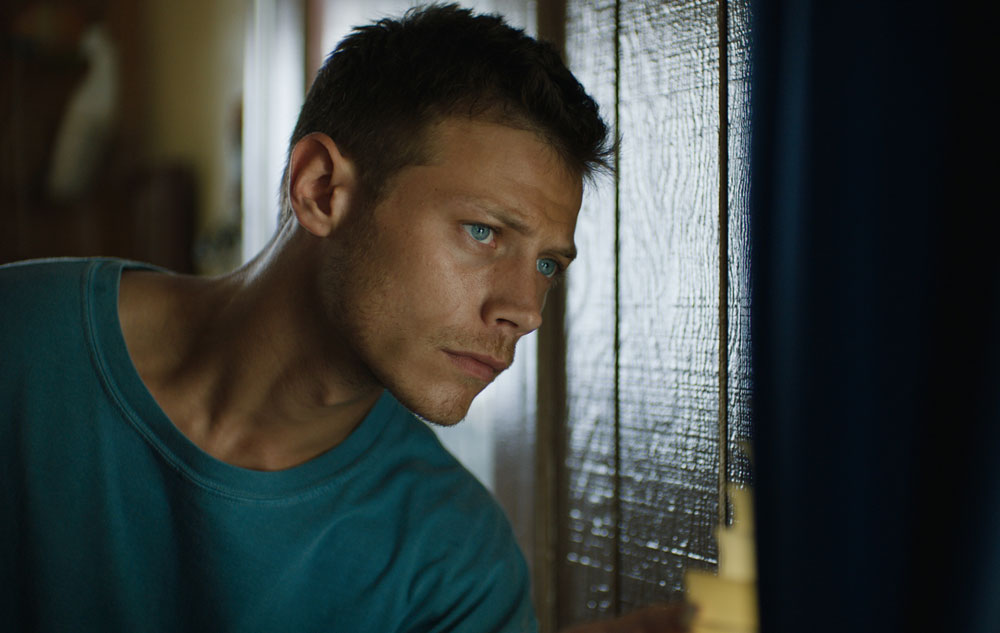It isn’t easy to get in and out of Dundalk, Maryland to Baltimore, where Matthew Porterfield is based, but of course, those are the places where the writer/director likes to go. Ever since his beguiling first feature “Hamilton,” about a pair of young adults dealing with parenthood long before they’re ready, becoming part of a continuum in their community that continues to weigh it down, Porterfield has told stories that are as emotionally precise as they are geographically, where characters carry the weight of history on their shoulders that they had no part in creating themselves.
Hence, the excursion into Dundalk for his latest feature, “Sollers Point,” a riveting character study of a young man named Keith (McCaul Lombardi), who is entering probation when we first meet him. Appropriately enough, he served time under house arrest for a crime that’s never made clear, but living inside the house of his father (Jim Belushi), across the street from his ex-girlfriend (Zazie Beetz) is likely more painful than any jail cell ever could be since he constantly faces the frustration of knowing he’s disappointed the ones he’s loved every time he looks outside. Porterfield, long gifted with the ability to bend the every day towards a compelling narrative arc, follows Keith gently back into society, albeit with an ankle bracelet, as he attempts to eke out a semblance of his old life on the straight and narrow by revisiting all the people and places he knew from before, through honest work is hard to come by and guys he knew from prison actually think they’d be doing him a favor by throwing some of their odd jobs his way.
While Keith feels unwanted on one side of the law and resistant to breaking it again, the constant struggle proves to be an electrifying drama, particularly when driven by Lombardi’s magnetic performance as someone decent, charming and thoughtful with a temperamental streak. You can see the world impressing itself upon him from every interaction he has, and with Porterfield covering as much of greater Baltimore as he can, one can see exactly how the culture has shaped him, for better or worse, yet with tremendous respect for everyone who is just trying to get by. As the film makes its way out of Maryland into theaters across the country, Porterfield spoke about how “Sollers Point” came into being, adjusting his process to involve higher-profile actors, and the challenges with having a fair amount of a film’s action inside of moving cars.
I was really interested in the idea of a character who is transitioning after some time in prison and looking for work and meaning in his life and I was also interested in creating a character who was very impulsive and angry and I was thinking a lot about some of the themes [from] “Hamilton” and “Putty Hill” and I wanted to stay in this working class milieu. So it was a desire to paint another portrait of a young man of the middle class in Baltimore. Usually, there’s a character that’s tied to a specific image [I’m inspired by], and in this case, it was a man with an ankle bracelet with a literal shackle on it. I was interested in his limited mobility, so it was a question of who was this character, why is he in this situation, what is he going to do, where would he go?
After I have my character in my head, I think pretty soon after about where that character lives, so I’m typically doing some location scouting and thinking about the environment. I was really interested in this neighborhood called Turner Station, which was part of a larger enclave called Dundalk, a company town incorporated by Bethlehem Steel in the ‘40s and ‘50s that I always wanted to tell a story [about] because the history of the steel industry there. I was specifically interested in depicting a neighborhood where my family settled before I was born — my grandfather as a steelworker, my grandmother in an area called Wagner’s Point, which is no longer. For me, it was trying to dig into these places that I haven’t known myself intimately, but where my family was raised, and [there’s a] strong maritime tradition — [Dundalk] is on the water of the Chesapeake Bay, so I really wanted to show this place onscreen. But we also went further north to the neighborhoods we visited in “Hamilton” and “Putty Hill,” and southeast to a neighborhood called Curtis Bay.
I understand you were thinking Keith would be older at one point, but finding McCaul changed your mind. What was it about him that made you want to cast him and how did it change the film?
As soon as I met him, he had the right look and he was really intelligent. I just got the sense that he was thoughtful, [had] the right kind of rough edge and that he knew a lot of people like Keith himself growing up. He’s from Baltimore, so it’s great. He can stay at home until we put him up in an apartment in the area where we shot the film. We brought him down about a month-and-a-half before we started shooting and we spent a lot of time in the neighborhood. He was there on our location scouts and we would drive around together. We visited prisons together, so he could interview some inmates and we did a lot of research in that preparatory period.

I was reading a lot of gang literature and was thinking about gang members that I’ve spoken to over the years and I was interested in the character who had a high level of moral superiority – who was not directly engaged in illegal activity, but was running a gang like a fraternal organization and what he would say to a young man who comes to him for help. I wanted for it to be obtuse and difficult to understand, if it made any sense at all, and I borrowed from different sources — the Bible and rap songs that I love. I just tried to create something that was sort of vaguely neo-fascist and white power and as confusing and opaque as possible.
Is it interesting to mix locals with the actors that you bring in from the outside?
Yeah, that can be a challenge certainly when you mix seasoned professional actors and nonprofessional actors. It doesn’t always work, but we were lucky in this case because all the pros were really generous and patient with some of the newcomers they were asked to work with or opposite. It gave a lot of confidence to the relative newcomers. They understood we were all in this together, there was no hierarchy and we all wanted what was best for the film. I don’t think it’s probably always that way. You might get an actor who doesn’t like to rehearse or requires a certain amount of time before a take to get into character, but everybody here was just a super-pro and super hard-working and down to bring this film to life.

It was a new way of working for me, but it didn’t change much. When you’re working on a limited budget, you can only afford to bring actors in for their minimum amount of time and in this case, we had bigger actors like Jim Belushi and Zazie Beetz, but the amount of time we had to work with them was consistent with the amount of time I had on my other films. Scheduling was maybe a tiny bit more difficult, but it didn’t change my working methods at all. A lot of the actors were really on set for one day, and it was a lot for [McCaul], who had to interact a lot with all these different actors, and thankfully, they were all really professional and cared a lot about their scenes. But it was fun. It was like the making of a road movie where you meet these characters briefly for a short amount of time and then you move on.
I also loved the use of camera movement in relation to Keith specifically – at times, you can feel how he’s trapped while at others, you express his restlessness as if he’s running in place. How did you figure out what would motivate the movement?
That was something my cinematographer Shabier [Kirchner] and I thought a lot about. We walked through the script multiple times, just trying to find justification for all the movements, for all the tight shots and usually, it was based on how close do we want to be to the character. It was just time spent at the script stage, talking through everything and trying to feel it out before shooting. It was instinctual, but we wanted to stay close to Keith and motivate the camera movement by the action as much as possible.

Yeah, it was really challenging because [camera] mounts take a long time. We had a lot of different kinds of car rigs because we wanted to provide a diversity of camera angles in relation to the car, so it didn’t get redundant. But cars are tough. There’s the rigging, but then there’s [also] the coordination — there’s typically a police escort involved and hopefully traffic lights time right and continuity is really a challenge as well. They were some of our hardest days. I wrote so many into the script and there were days when I regretted it.
Was there a particularly crazy day of shooting?
The hardest was the day where we shot all the scenes with Elaine, the woman that Keith picks up who’s heading to the methadone clinic, at least on the second trip. That was a really important and emotional performance she was delivering and it was a long drive. It had to end at the exact right spot at this corner where there’s a methadone clinic, adjacent to a graveyard. But the methadone clinic is extremely busy. It’s a transit hub. There’s a lot of people out on the street. There’s a gas station there, and you’re not allowed to shoot in the graveyard — we had to pretend we were driving up to the graveyard and get inside at another time — but everything timed perfectly. We were very lucky in that regard that the dialogue ended as Keith drove up to the methadone clinic and we got the scene in its entirety. We did multiple takes of course, but we nailed it in one and I couldn’t have been happier.
“Sollers Point” opens on May 25th in Los Angeles at the Monica Film Center and Washington DC at the West End Cinema, June 1st in Santa Fe at the Jean Cocteau Cinema, Denver at the SIE Film Center and San Diego at the Digital Gym Cinema and June 8th in Seattle at the Grand Illusion Cinema, Columbus, Ohio at the Wexner Center and Lake Worth, Florida at the Lake Worth Playhouse.





